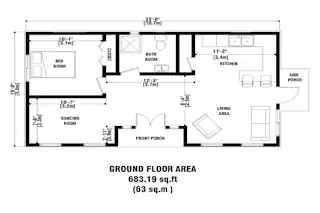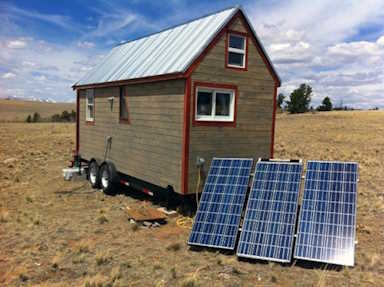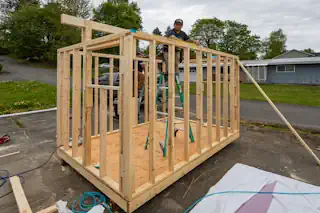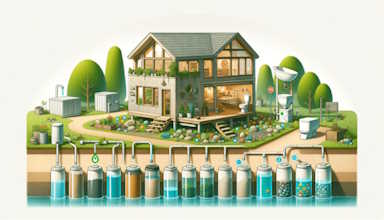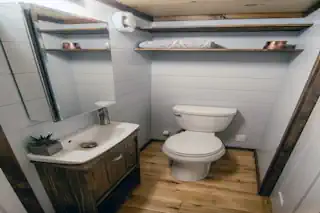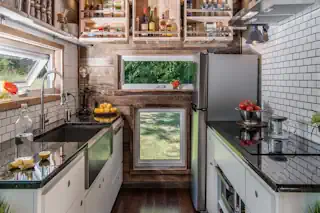Tiny Homes: A Sustainable Lifestyle Choice
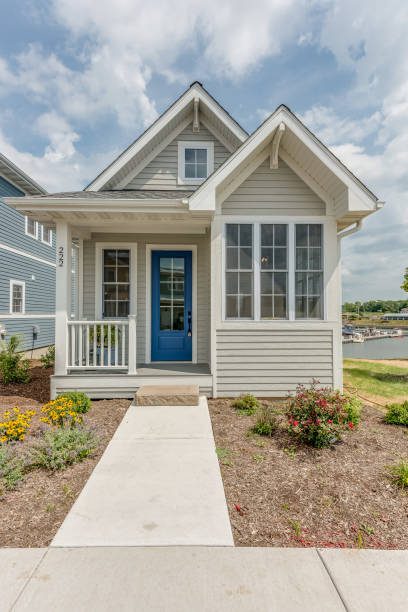
In a world where space always seems to be increasing at a premium and the pursuit of sustainability is more than just a trend, tiny homes represent a radical redefinition of what it means to live large. Encapsulated within the cozy confines of these pint-sized dwellings is a movement that has captured the imagination of many, promising a lifestyle that is not just financially liberating, but fundamentally earth-friendly and liberating. If you find yourself yearning for a simpler, more sustainable existence, then tiny home living could be the answer you’ve been looking for.
The Allure of Tiny House Living
A Paradigm of Sustainable Living
Tiny homes epitomize sustainable living. By their very nature—small, compact, and often mobile—these dwellings speak to a philosophy that cherishes a smaller ecological footprint. With lesser amounts of materials used in construction, lower energy needs for day-to-day living, and a profound message about the beauty of living with less, tiny homes are a clear step in a greener direction. But this eco-friendly narrative is just one layer of the appeal.
Financial Independence and Freedom
For those tired of the cycle of debt and the relentless pursuit of larger, costlier homes, the tiny home lifestyle offers a breath of fresh air. The reduced cost of building and maintaining a tiny home often means freedom from mortgage burdens and the ability to live more within one’s means. This aspect of tiny house living ensures that financial freedom is not a far-flung dream, but a tangible reality for many who choose this path.
Living a Simpler, More Meaningful Life
Beyond the economic and environmental benefits, one of the core attractions of tiny home living is the promise of a simpler, more meaningful existence. Stepping into a tiny home often means stepping into a life stripped of unnecessary possessions and complexities. It’s a life that encourages mindfulness, intentionality, and an appreciation for the small joys that make up the fabric of our daily lives.
Benefits of Downsizing to Tiny Houses
- Reduced Environmental Impact: Smaller homes require less material to build and less energy to heat and cool, directly contributing to a more sustainable planet.
- Financial Savings: The cost associated with purchasing, maintaining, and renovating a tiny home is significantly lower, offering substantial savings over time.
- Simplicity and Minimalism: Living in a smaller space encourages a minimalist lifestyle, helping individuals to prioritize possessions and reduce clutter.
- Increased Mobility: Many tiny homes are built on wheels, offering the flexibility to move and explore new locations as desired.
- Closer Family Bonds: The compact living space encourages more interaction and deeper connections among family members or roommates.
- Lower Energy Bills: Due to their small size, tiny homes consume much less energy, resulting in lower utility bills.
- Opportunity for Customization: Building a tiny home offers the chance to customize your living space to your exact needs and preferences, often at a lower cost than traditional homes.
- Enhanced Focus on Outdoor Living: With less space inside, tiny home residents often spend more time outdoors, enjoying nature and expanding their living space into the surrounding environment.
Reduced Environmental Impact: A Step Toward a Healthier Planet
Utilizing less space and resources, tiny homes exemplify an eco-conscious lifestyle that significantly minimizes one’s carbon footprint. This conscientious approach to living not only benefits the individual homeowner by fostering a more sustainable and responsible lifestyle but also contributes positively to the broader environmental cause. It’s a tangible demonstration of how individual choices can lead to broader societal impacts on ecological sustainability.
The environmental benefits of tiny home living cannot be overstated. These miniature homes use substantially fewer resources during construction, and the reduced living space leads to less consumption of energy for heating, cooling, and running appliances. Pair this with the opportunity to live off-grid or the lowering of one’s carbon footprint, and you have a compelling argument for why tiny homes are an eco-warrior’s dream.
Financial Savings: Unlocking a World of Possibilities

Living in a small house can mean big savings. With less to buy and maintain, the financial benefits of tiny living are significant. Reduced property taxes, lower utility bills, and the prospect of an affordable, debt-free lifestyle are just the beginning. For those with an adventurous spirit, the mobility of many tiny homes means the ability to live in a variety of landscapes without the burden of selling or relocating a cumbersome house.
The financial advantages of tiny home living extend beyond mere savings on purchase and maintenance costs. This economic liberation opens up a wealth of possibilities, from investing in experiences rather than material possessions to having the financial freedom to pursue passions and hobbies that were previously beyond reach due to financial constraints. It’s about breaking the cycle of living paycheck to paycheck and carving out a more financially stable and fulfilling life.
Wanting to have your own home or own tiny home is something many of us dream of. Small homes can make this a reality for anyone. Embracing a tiny house just might be the next adventure to living big with your dreams.
Simplicity and Minimalism: A Path to Clarity and Focus
Choosing to live in a tiny home is often a conscious decision to adopt a more minimalist lifestyle, which can lead to greater clarity and focus in life. This reduction in physical clutter translates to a decluttering of the mind as well, allowing individuals to concentrate on what truly matters to them, be it personal growth, relationships, or other pursuits. It’s a step towards a more deliberate and fulfilling existence.
What tiny homes lack in size, they make up for in practicality. Everything in a tiny home is designed with a purpose, and redundancy is practically non-existent. This ethos of intelligent design and minimalism fosters an organized and clutter-free environment, ultimately leading to a more relaxed and stress-free lifestyle.
Increased Mobility: The Freedom to Explore and Grow
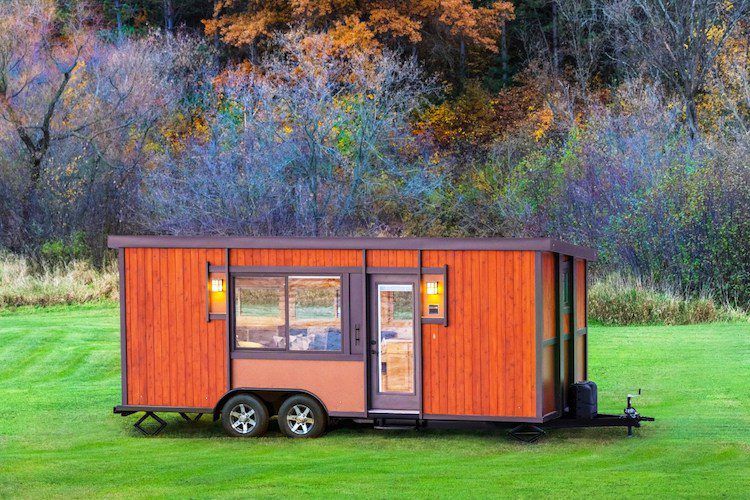
The inherent mobility of many tiny homes presents a unique opportunity to explore new locations and experiences without the anchor of a traditional, stationary home. This nomadic aspect of tiny home living appeals particularly to those who value freedom and adventure, enabling them to break free from the constraints of a single geographic location and enrich their lives through diverse experiences and environments.
Closer Family Bonds: Strengthening Relationships Through Proximity
Compact living spaces naturally foster closer interaction and communication among residents, whether they are family members or roommates. This close-knit living situation can strengthen relationships, encouraging more quality time together and creating a strong sense of community and mutual support within the tiny home. It’s about transforming necessity into an opportunity for deepening bonds.
Lower Energy Bills: Economical and Ecological Benefits
The small footprint of tiny homes leads to substantially lower energy consumption for heating, cooling, and daily living, resulting in significantly reduced utility bills. This efficiency is not only financially beneficial but also environmentally responsible, aligning with the sustainable ethos that often attracts individuals to the tiny home lifestyle in the first place.
Opportunity for Customization: Creating Your Ideal Living Space
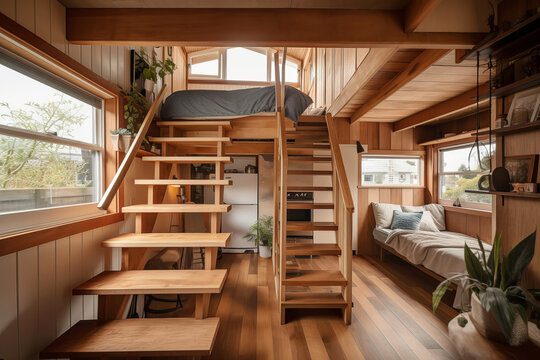
The process of designing and building a tiny home offers unparalleled opportunities for customization. With each square foot needing to be thoughtfully considered, homeowners have the freedom to truly tailor their living environments to their personal tastes, needs, and lifestyles. This customization contributes to a level of personal satisfaction and emotional connection with one’s home that may be more difficult to achieve with traditional housing.
Enhanced Focus on Outdoor Living: Extending the Living Space Beyond Four Walls
Living in a tiny home often encourages residents to engage more actively with the world outside their door. Whether it’s setting up outdoor living spaces, engaging in more physical activities, or simply appreciating the natural environment, the tiny home lifestyle promotes a healthier, more active engagement with the outdoors, enriching the lives of its inhabitants and fostering a greater appreciation for the natural beauty that surrounds them.
Preparing for Tiny House Living: What to Consider
Space Optimization
Living in a tiny home is a lesson in space management. You’ll need to be strategic about every square inch, which means selecting multi-functional furniture, employing smart storage solutions, and potentially paring down your possessions to the essentials. This transition might sound daunting, but the rewards of a space that is tailored to your every need and maximizes efficiency are well worth it.
Addressing Legal and Regulatory Hurdles
For many prospective tiny home dwellers, navigating the legal landscape can be the most significant challenge. Zoning laws, building codes, and regulations vary widely and frequently do not account for tiny homes, leading to a legal gray area. Before going tiny, it’s critical to research and understand the zoning and building regulations in your area to avoid any unpleasant surprises down the road.
Utilities and Amenities
One of the assumptions of tiny home living is a reduced dependence on utilities. However, sourcing your power, water, and waste management can require some creative solutions to live comfortably and within the realm of sustainability. Solar panels, composting toilets, and rainwater collection systems are just a few popular options that can keep your ecological footprint small while still meeting your daily needs.
Immersing Yourself in the Tiny Home Lifestyle
The Art of Decluttering and Minimalism
Preparing for simple living in a tiny home often begins with a radical decluttering of one’s possessions. This process, while initially challenging, paves the way for a more minimalist lifestyle where quality outpaces quantity, and each item is imbued with value. The rewards of a decluttered home—both aesthetically and mentally—can be immensely satisfying.
The Joy of DIY and Personalization
One of the most exciting aspects of tiny homes is the opportunity to personalize and craft your living space to your exact specifications. Whether it’s through the construction process, upcycling and repurposing materials, or creatively decorating the interior, the hands-on nature of tiny home living can be deeply fulfilling for those with a DIY spirit.
The Tiny House Community
The tiny house movement is much more than a housing choice; it’s a community of individuals bound by a shared ethos. Engaging with local tiny home groups, attending meet-ups, and sharing experiences can provide a sense of camaraderie and support. This network can be invaluable, offering advice, friendship, and a place to turn when the challenges of tiny living rear their heads.
Tackling the Challenges of Tiny Home Living
Navigating the Tight Quarters
There’s no denying that living in a small space comes with its fair share of challenges. Privacy can be at a premium, and entertaining guests may require a bit of creativity. However, many who have made the leap to tiny living find that these obstacles are more than offset by the cozy, intimate atmosphere that tiny homes provide.
Zoning and Regulatory Hurdles
The ambiguous legal status of many tiny homes can lead to difficulties in finding a permanent parking spot or securing financing. This can be a significant barrier for those looking to make the transition to tiny living. Staying informed, advocating for legal recognition, and connecting with local advocacy groups may help to alleviate some of these challenges.
Meeting Your Daily Needs in a Small Space
Adapting to a life with reduced utilities and amenities requires some lifestyle adjustments. Cooking, cleaning, and organizing in a small kitchen or bathroom can take some practice. Pre-planning and developing routines can help to ease the transition and ensure that your tiny home remains functional and comfortable.
In Conclusion
Tiny home living is not just a passing fad; it’s a sustainable lifestyle choice that is gaining traction. By choosing to downsize to a tiny home, you’re not just simplifying your living space, but you’re also making a statement about your values and your commitment to a greener future. While there are certainly challenges to be met, the sense of independence and fulfillment that comes with tiny home living is unparalleled. If you’re drawn to the ideals of minimalism, self-sustainability, and community, then exploring the world of tiny homes may be the next step in your life’s adventure.
Frequently Asked Questions (FAQ)
What is the average cost of a small home?
The cost of a tiny home can vary widely depending on factors such as size, materials, and whether you choose a DIY build or a custom-built home from a professional. On average, tiny homes cost between $30,000 and $60,000.
Can I live in a tiny home with pets?
Yes, many tiny home dwellers live comfortably with pets. The key is to design your space with your pet in mind, considering their needs for space, exercise, and comfort.
How do I find a place to park my tiny home?
Finding a legal place to park can be challenging due to zoning laws. Researching local regulations, connecting with tiny home communities online, and considering tiny home-friendly RV parks are good starting points.
Are tiny homes environmentally friendly?
Tiny homes can have a smaller ecological footprint compared to traditional housing. Using sustainable materials, solar power, and water-saving appliances can further increase their eco-friendliness.
How do tiny homes handle utilities like water, electricity, and sewage?
Tiny homes often utilize off-grid solutions like composting toilets, rainwater collection systems, and solar panels. Connecting to existing utility infrastructures is also an option, depending on your location.
Can I finance a tiny home?
Financing a tiny home can be difficult through traditional banks, as tiny homes often don’t qualify for traditional mortgages. Specialized tiny house lenders, personal loans, and RV loans are alternative financing options.
How long does it take to build a tiny home?
The build time for a tiny home can range from a few months to a year, depending on whether it’s a DIY project, the complexity of the design, and the amount of time dedicated to the build.
